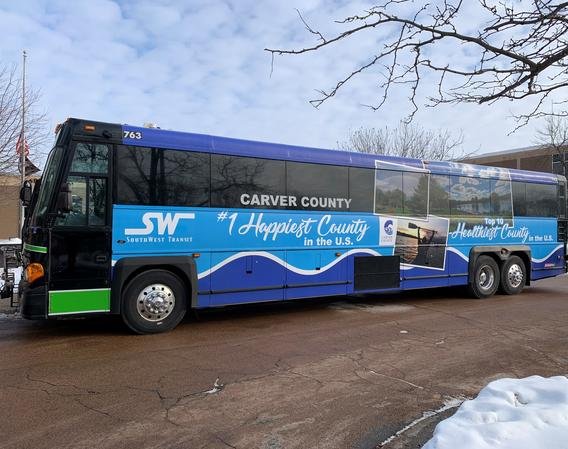ISyE, Public Affairs Students Offer Ideas for Transit Changes in Carver County

The transit needs of Carver County, Minnesota, are undergoing a shift driven by changes in population size and demographics. Student researchers from the U of M teamed up with county planners to identify and address these changing needs.
The students partnered with Carver County through the Resilient Communities Project. RCP, housed in the U’s Center for Urban and Regional Affairs, is a program that connects local government agencies with U students and faculty to advance community resilience and student learning through collaborative, course-based projects.
“Essentially, we told the students that we wanted to have a better understanding of what transit needs were being unmet in the county,” says Adriana Atcheson, project lead and a planner with Carver County. “I think in some cases they even exceeded what we were asking them for.”
Carver County, which is located southwest of Minneapolis, is expected to experience an uptick in population—around 50 percent growth—within the next 20 years, according to demographic data collected by the project team.
The major transit options in Carver County include Transit Link, a ride-sharing service for general populations; SouthWest Transit, which provides fixed-route service to several destinations, including downtown Minneapolis, as well as demand-response services in the communities that make up its service area; and Metro Mobility, a transit provider aimed at people with disabilities or health conditions.
The county has a mix of urban, suburban, and rural land use, and the students note that some of the faster-growing cities—such as Victoria and Waconia—are turning into suburban commuting areas. As the population grows, this will put increased strain on existing transit options as people attempt to commute to jobs within the Twin Cities region.
The percentage of people over the age of 65 in Carver County, as in Minnesota as a whole, is expected to increase over the next 20 years. Many people in this demographic do not drive and rely on public transit. The students found that transit options are limited for this population in the more rural parts of the county (Metro Mobility does not service many of these areas), and the team predicts that a rising number of older residents will put additional strain on the system.
After gathering this information through literature reviews and data analysis, the students put together a list of recommendations that the county could potentially use to address these “gaps” in the transit system. Recommendations include:
- Expanding Transit Link’s service to weekends.
- Adding a SouthWest Transit line that runs from Waconia and Victoria to downtown Minneapolis.
- Extending Metro Mobility’s service beyond suburbs to rural towns.
- Creating a centralized source of information about all transit options in the county.
Building on the students’ work, Carver County sent a transit behavior survey to residents in June to gather more information. The survey, for example, asks county residents questions about ease of access to transit.
Overall, Atcheson says, the RCP project serves as a means of getting everyone in the county on the same page. Carver County has a 2040 Comprehensive Plan, with goals related to creating a strong, multimodal, and more coordinated transit system. The RCP project helps identify gaps in the system so that the county and its transit provider affiliates know where to focus.
“I think it was just really helpful to have an outside perspective and to have someone look at the entire county more comprehensively, rather than just one city or a small transit area,” Atcheson says.
The project took place over two semesters. Students from the first semester, advised by Emily Kalnicky, were Dragan Glavas, David Gottfried, Ashley Hirilall, and Jiapeng Yan from the Humphrey School of Public Affairs. Students from the second semester were Katherine Mueller, Jacob Nordgren, Zach Stibbe, and Spencer Stumpff from the Industrial and Systems Engineering Senior Design Project, advised by Professor Saif Benjaafar.
Story from the Center for Transportation Studies
Written by Sophie Koch